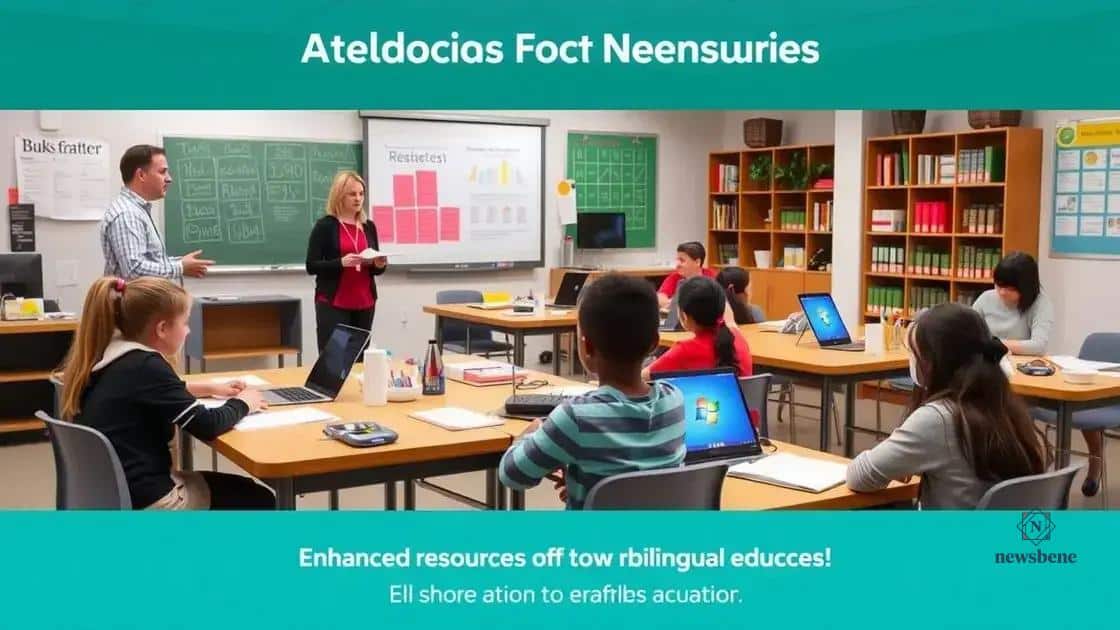Allocation of funds for bilingual learning programs is essential

Allocation of funds for bilingual learning programs enhances educational quality by providing necessary resources, improving teacher training, and fostering community involvement, ultimately leading to better student outcomes.
Allocation of funds for bilingual learning programs plays a crucial role in enhancing educational outcomes. But have you considered how these funds directly impact students’ experiences? Let’s dive into the importance of such investments.
Understanding bilingual learning programs
Understanding bilingual learning programs opens up a world of opportunities for students and educators. These programs aim to enhance language skills by teaching students in two languages. But what does this really mean for learning?
Benefits of Bilingual Learning
There are numerous benefits to embracing bilingual education. Learning in two languages not only helps in communication but also boosts cognitive skills. Students often show improvement in problem-solving abilities and creativity.
- Improves overall academic achievement.
- Enhances critical thinking skills.
- Promotes cultural awareness and sensitivity.
As students engage with both languages, they gain an appreciation for different cultures. This understanding fosters a more inclusive environment, which is vital in today’s global society. Teachers play a key role in facilitating this environment by incorporating diverse materials and teaching methods.
Key Components of Bilingual Programs
Effective bilingual learning programs often include specific components that ensure success. For instance, structured curricula that balance both languages while addressing various subjects are crucial.
- Curriculum focused on both languages.
- Access to bilingual resources.
- Teacher training in bilingual education.
Additionally, community involvement significantly enhances these programs. Families and community members can provide support, resources, and a rich context for students to practice their language skills outside of school.
Furthermore, regular assessment and adaptation of the programs are necessary to meet students’ needs. Schools can ensure that bilingual learning remains effective by keeping track of students’ progress and making necessary adjustments based on their performance.
The impact of funding on bilingual education
Understanding the impact of funding on bilingual education is crucial for schools and communities. Adequate funding can transform classrooms, enabling them to support diverse language needs effectively. This investment helps in creating an environment where students thrive.
Increased Resources
When schools receive sufficient funding, they can invest in essential resources like books and technology. These materials play a key role in effective bilingual instruction.
- Access to quality bilingual textbooks.
- Interactive learning tools that engage students.
- Professional development for teachers to enhance their skills.
As resources improve, so does the learning experience for students. With the right tools at their disposal, educators can create engaging lessons that cater to various learning styles.
Teacher Training and Support
Another significant aspect of funding is the ability to provide comprehensive training for teachers. Proper training ensures that educators are well-prepared to handle the challenges of bilingual education.
- Workshops focused on bilingual teaching strategies.
- Collaboration opportunities with other bilingual educators.
- Support systems for ongoing professional development.
Furthermore, when teachers feel confident in their abilities, they are more likely to inspire and motivate their students. This leads to better student engagement and achievement.
The ripple effects of funding extend beyond classroom resources and training. Enhanced funding fosters a stronger community partnership, allowing schools to engage families in the learning process. Community involvement is vital in reinforcing the importance of bilingualism and helping students practice their language skills in real-life situations. Additionally, families can participate in programs that support their children’s bilingual education.
How funds improve resources and teacher training

Understanding how funds improve resources and teacher training is essential for enhancing bilingual education. Adequate financial resources allow schools to provide better materials and support for both students and educators. This investment reflects the commitment to quality education.
Enhancing Learning Materials
When schools allocate funds appropriately, they can invest in a variety of essential learning materials. These resources can include updated textbooks, technology, and teaching aids that support bilingual education.
- Procuring high-quality bilingual textbooks.
- Introducing interactive software and apps that engage students.
- Providing access to online platforms for additional practice.
The availability of these resources makes it easier for students to understand complex concepts in both languages. Additionally, engaging materials can spark a greater interest in learning among students, making lessons more enjoyable.
Investing in Teacher Training
Funding also plays a crucial role in providing training for teachers. Well-trained teachers are better equipped to handle the unique challenges of bilingual education. Professional development opportunities help them acquire new techniques and strategies.
- Workshops focused on innovative teaching methods.
- Opportunities for collaboration with fellow educators.
- Access to ongoing support and resources post-training.
Teachers can incorporate these strategies into their classrooms, leading to improved student outcomes. When teachers feel confident in their abilities, they create a positive learning environment that motivates students.
Furthermore, the impact of funds extends beyond just resources and training. Schools that are well-funded can also offer extracurricular activities and programs that enhance language skills outside of the classroom. These programs foster community involvement and create a supportive network for families and students.
Community involvement in funding decisions
Community involvement in funding decisions is a vital aspect of enhancing bilingual education programs. When families and community members actively participate, they can influence and shape how funding is allocated. Their insights and experiences provide valuable perspectives.
The Importance of Community Input
Engaging the community in funding discussions helps ensure that the needs of students are met. Parents and guardians often have unique insights about what resources their children require for effective learning.
- Identifying specific language needs for students.
- Providing feedback on existing educational materials.
- Suggesting new programs that cater to diverse backgrounds.
Furthermore, when communities collaborate with schools, they can build a supportive environment that benefits everyone. This partnership helps foster trust and commitment to shared educational goals.
Creating Shared Goals
When communities come together with schools, they can establish shared goals for funding initiatives. These goals ensure that the funding aligns with the needs and aspirations of the students and families.
- Developing programs that reflect community values.
- Addressing disparities in educational access.
- Enhancing resources that promote bilingual proficiency.
Moreover, clear communication about funding processes can help demystify how decisions are made. When families understand the funding landscape, they feel empowered to voice their opinions and advocate for their children.
Community organizations can also play a critical role in supporting funding efforts. Through fundraising activities and resource allocation, these organizations can contribute to the sustainability of bilingual programs. They often serve as facilitators, connecting schools with potential donors and resources that may not be readily available otherwise.
Evaluating the success of bilingual programs
Evaluating the success of bilingual programs is essential for understanding their effectiveness. By assessing various components, schools can gain insights into how well these programs meet the needs of students and communities. This evaluation helps in identifying areas for improvement and celebrating successes.
Key Performance Indicators
To effectively evaluate bilingual programs, certain key performance indicators (KPIs) should be considered. These metrics provide a clear picture of how well students are performing and progressing.
- Students’ academic achievement in both languages.
- Improvement in language proficiency over time.
- Student engagement levels and attendance rates.
Tracking these indicators can help educators see trends and make informed decisions about necessary changes. A strong performance in these areas often signals a successful bilingual program.
Feedback from Stakeholders
Gathering feedback from various stakeholders is also crucial in the evaluation process. Parents, teachers, and students can provide valuable insights regarding the program’s strengths and weaknesses.
- Parent involvement and satisfaction levels.
- Teacher assessments of student progress.
- Student feedback on the learning experience.
When stakeholders share their experiences, it creates a holistic view of the program’s impact. This feedback helps school leaders identify effective practices and areas needing attention.
Additionally, regular assessments and tests can help measure student growth. Using standardized tests can provide objective data on language acquisition and academic performance. These assessments can complement qualitative feedback from interviews and surveys.
Finally, comparing bilingual programs with traditional programs can highlight the benefits of bilingual education. Metrics such as graduation rates and college readiness can serve as benchmarks for success, demonstrating the long-term advantages of bilingual learning.
FAQ – Frequently Asked Questions about Bilingual Education Programs
What is the main goal of bilingual education programs?
The main goal is to enhance language skills by teaching students in two languages, improving both academic performance and cultural awareness.
How does funding impact bilingual programs?
Funding provides essential resources, training for teachers, and materials that support effective bilingual instruction.
Why is community involvement important in bilingual education?
Community involvement helps shape the programs to better meet the needs of students and promotes trust among families and schools.
How can program success be evaluated?
Success can be evaluated by tracking key performance indicators, gathering feedback from stakeholders, and assessing student progress.






